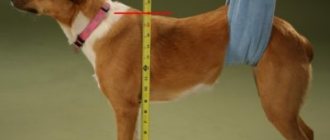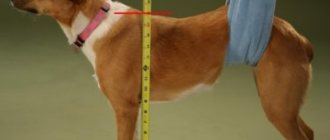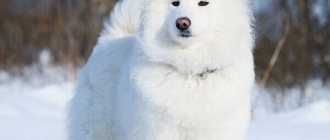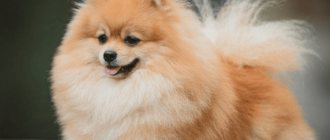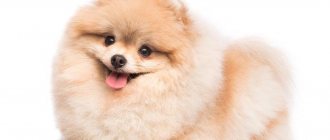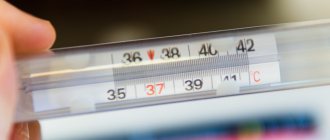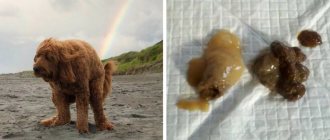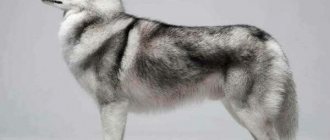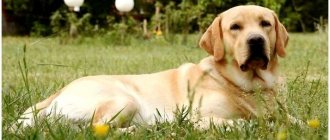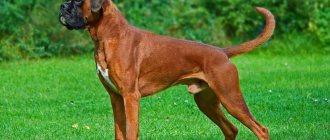Taking into account the pet’s parameters is necessary to monitor its development, determine compliance with the breed’s exterior, and calculate medication doses.
To select the correct collar, harness, or winter overalls, you need to measure your height at the withers.
Not all breeders know how to correctly determine this indicator. It is not difficult to learn this if you follow the basic techniques and follow the instructions.
Learning to correctly measure a dog's height at the withers
The withers are not only an important area of the back, from where all the measurements necessary to determine the size of the dog begin. It is also a place at the base of which there is a large concentration of blood vessels, which makes the withers an ideal base for applying various medications. In our article we will try to determine where the withers are located in dogs and how to correctly measure the height of a pet.
Dog withers: what is it and how to find it
The withers are a section of the spine located between the shoulder blades of four-legged animals. As a rule, for many animal species this is the highest point of the body. It is from the withers that height is measured in dogs and horses. The withers in dogs are formed from five vertebrae of the spine.
Why does a pet owner need to know where the animal’s withers are? The answer is quite simple: any measurements of an animal are usually taken from this point. In addition, many medications are applied specifically to this area of the back. The fact is that this area of the back is literally penetrated by a network of small vessels, and this allows medications to be well absorbed. Most often, injections are given in the withers area or anti-flea and tick medications are applied. The photo below gives a detailed explanation of how to determine the position of the withers.
Horses
In horses, the withers are formed by the part of the spine between the 3rd and 11th dorsal vertebrae (most horses have 18 dorsal vertebrae), which are unusually elongated in this part of the body. In a horse, the vertebral processes can reach over 30 cm in length.
Since the withers do not move relative to ground level (in both horses and dogs), they are used to measure a horse's height. Typically, a horse's height is measured in palms - one palm measures 4 inches (10.16 cm). Horses can vary greatly in size, from small ponies to large draft horses. The average height at the withers of a purebred horse is 16 hands (1.6 m), for a pony - 14.2 hands (1.44 m).
Measuring the height of a dog
Any control of the development of puppies, as well as determining the standard of a particular breed, requires certain measurements. First of all, it is a measurement of growth. We will talk further about how to correctly take this measurement.
From the video “Medical procedures and the withers of an animal” you will learn how to properly give injections in this area of the back.
Instructions
Below is a complete list of points, following which, you can correctly determine your height. Height is determined by measuring the distance from the highest point of the animal's body (withers) to the floor. In order for the measurements to be accurate, the pet must be placed on a flat horizontal surface. Most likely, you will need an assistant who will hold the animal in an even position, but without much strain on the muscles and paws.
Small breeds are best measured on a flat table surface, while large animals will be more comfortable on the floor. You can correctly determine the starting point by applying a ruler or book to the withers. A special stadiometer is usually used for measurement. However, if you don’t have it on hand, you can use the following methods.
- Two rulers. One of them should be placed on the pet’s back, the other should measure the distance from the floor to the second ruler. The best way to do this is shown in our photo.
- Children's method. If you are the owner of a large dog, you can measure your pet the same way you measure children. Place the animal against the wall and make a mark where the shoulder blades are located. This method is unlikely to be suitable for small breeds.
Height directly depends on the size of the breed to which the pet belongs. It is important to understand that this parameter may differ from breed standards if your puppy’s parents were representatives of different breed groups. In addition, in mongrels and mixed breeds, it is generally impossible to predict it, since a large amount of blood is mixed there. Therefore, the size of a mature puppy can significantly exceed the size of its parents.
Photo gallery
Photo 1. Carrying for a large dog
Photo 2. Height meter
Photo 3. Measuring height using rulers
Photo 4. Carrying for small breeds
Why is a pet's height measured?
An owner may need to measure a pet's height in the following cases:
- control of the puppy’s physical development;
- determination of breed membership;
- establishing the possible jump height of a dog participating in agility competitions;
- choosing and purchasing a dog carrier;
- buying clothes or harnesses for your pet.
Let's talk about each of the points separately. Analysis of the physical development of a puppy is impossible without determining its size. So, it is important for the owner to know not only the weight and height of a small pet, but also the circumference of the chest and paws.
At any breed dog show, a mandatory part of the examination is to determine the height of the animals, and in the presence of an expert, to make sure that the height at the withers of the dog meets the standard. This ritual is required to determine whether a pet belongs to a particular breed. The table shows the height of dogs of several popular breeds.
Correlation with standard
Growth standards have been established for each breed of the dog family. As an example, here are the values typical for cables of common types:
- Dalmatian, 56-62 cm,
- Labrador Retriever, 56-57 cm,
- Great Dane, 80-90 cm,
- Saint Bernard, 70-90 cm,
- Giant Schnauzer, 60-70 cm,
- German boxer, 57-63 cm,
- beagle, 33-40 cm,
- Maltese, 21-25 cm.
The pet's height may not coincide with the standard if its mother and father belonged to different breeds. Unpredictable growth is also typical for outbred puppies: growing up, they can be much taller or shorter than their parents.
The tallest dog in the world, the Great Dane Zeus, is 111.8 cm tall at the withers. The god of canine Olympus lives in the American state of Michigan. Owners say that with a weight of 70 kg, the pet eats 14 kg of dog food per day. The barking giant does not fit in a passenger car, so for country trips I had to buy a truck.
N In search of the withers
The withers are the area of the body that begins immediately after the neck. These are the first 5 vertebrae of the back, which are located at its beginning, just between the shoulder blades. It is advisable for the dog owner to master a skill that helps determine the location of the withers and the folds of skin covering them. It is considered basic. It will be required in the following cases:
- When treating a pet with insecticidal agents, most often drops from parasites must be applied to the withers area, since their active components are slowly absorbed into the skin and do not suddenly enter the bloodstream. In some drugs, the active ingredients tend to accumulate in skin cells, and in the withers area it is less sensitive.
- When administering subcutaneous injections, the withers are the most suitable place to administer medicinal compounds for several reasons: this area is the least sensitive to damage, in addition, it has a cavity into which the entire dose enters at once, and there is no need to divide it into several doses.
- To control the growth and development of the puppy - this especially applies to purebred individuals, the parameters of which are indicated in the standard, and the owner can periodically weigh and measure the pet’s growth to make sure that it does not go beyond the norm.
- When selecting ammunition and accessories, the girth of the withers in this aspect is a fundamental characteristic.
- To choose a suitable wardrobe if your pet needs special clothing.
Detecting the withers is a simple task if the owner is experienced and the pet has a standard build. But even otherwise, you can use a special method that allows you to accurately detect the desired skin folds:
- You should put your hands on the dog’s shoulders and press them to the body;
- it is necessary to move your hands up, collecting the skin until it forms a fold;
- the arms are lowered until they rest on the shoulder blades;
- the skin in the hands is the scruff of the neck, which is also the fold on the withers.
In addition, you can detect a dog’s withers using a flat object, such as a book. It is placed on the withers area, and when it lies parallel to the floor, the desired point has been found. It is worth noting that the first person to find a puppy’s withers is his mother. It is with this that she holds the babies when she moves them. In common parlance this area is called the scruff of the neck.
K How to take the correct measurement
There are rules that should be followed if you want to get the most accurate data:
- The most suitable tool for measuring is a hard measuring stick, a tape measure or a tailor's yardstick, giving distorted results, usually the dog turns out to be 1-3 cm higher.
- Three measurements should be taken at intervals of 30 seconds to 1 minute. Taking all the results, you need to calculate the average value, which will be the final result.
- Adopting a stance is a must.
- Measuring instruments are applied in such a way that they fit snugly to the animal’s body, pressing the fur, but are not pressed into the skin. Owners of dogs with long hair are recommended to sort out the hair in the area where the tool is applied.
Owners of show animals are aware that their pet must be able to take a special stance in which it is measured. But why are measurements not taken from the head or nose? But the whole point is that even among representatives of the same breed, head posture can be different, which will lead to distorted measurement data.
Height at the withers is the distance from the support to the point where the neck and shoulder blades meet. In addition, the withers are the highest point on the animal's body. In a dog of any breed or without one, the “scratch” consists of five vertebrae, which are located between the shoulder blades.
To measure the dog, it must be stood up. Show class dogs are trained to accept it on a specific command - at the show no one will wait for the participant to stand up properly. If the pet does not have such a skill, the owner just needs to watch him - the dog takes such a stance when he is interested in something and carefully watches the object. It doesn’t matter what position his head and neck are in.
The dog should stand on a flat surface (a small four-legged dog can be placed on a table), and not be distracted by extraneous stimuli. You can attract her attention with a treat or toy. It is best if two people participate in the event. Next, you should focus on the dog’s behavior:
- if the dog is standing still, you can take measurements using a tape measure or 2 long rulers - one is placed on the dog’s back, the other is used to measure the distance from the floor to the ruler located on the back;
- a restless pet cannot be measured in this way - in this case it is better to make marks on the wall - the dog should be placed against the wall and a mark should be made at the shoulder blades.
The first method is good for measuring small and medium-sized individuals, the second - for dogs of impressive size. Growing and developing pets should be measured regularly. The best time for such a procedure is the period before a meal - the animal reacts more actively to treats.
There are a number of statistical tables with height and weight standards, and they are available for each registered and officially accepted breed. If the owner discovers that his puppy is not growing as expected, he should consult a veterinarian. In most cases, such deviations can be corrected, especially if detected at an early stage. Most often they are associated with eating disorders.
Necessary parameters for selecting accessories
When choosing clothes for your pet, you need to correctly determine its size. A mistake can lead to the fact that the chosen clothing will restrict the dog’s movements or dangle on it, causing irritation. This may cause the dog to completely refuse to wear the carefully chosen warm overalls.
To select dog accessories, you may need to not only measure the dog's height at the withers, but also chest circumference, neck circumference, head circumference and waist circumference. If you purchase socks or shoes, you will also need the circumference of the pastern and the size of the paw. In the production of dog accessories, there are a number of size tables that make the choice much easier for the owner. These tables are organized by breed and category.
Dog measurements for choosing accessories
When choosing accessories and clothing for miniature pets, you should focus on a separate size chart. The most commonly used table is provided by the famous brand ForMyDogs. The size range in it ranges from 8 to 20. At the same time, there are 2 additional sub-sizes - 10/chh and 12/chh. They assume the presence of two additional centimeters in chest volume with a standard back length.
K How to measure a dog to choose a harness
In this case, it is best to use a tailor's meter, which is used by tailors. With its help, you can measure not only the circumference of the animal’s neck, but also other parts of the body. To purchase the most suitable ammunition, the meter should be applied in such a way that it fits snugly without sagging. A harness for dogs not used as sled dogs requires three measurements:
- from the withers (scruff) to the base of the tail;
- the volume of the sternum at its widest point, just behind the front paws;
- neck volume.
To select a harness for a working sled dog, 2 measurements are required:
- the size of the area from the highest point of the nape to the base of the chest between the front legs;
- length from the base of the sternum to the base of the tail.
When purchasing working equipment, the most accurate measurements are required, since while riding the dog should not experience discomfort, pain or feel that anything is bothering him. A person's palm should be placed between the harness straps and the dog's body. This will help avoid discomfort and constraint while moving. If the harness is too loose or too tight, it will not only be uncomfortable for the dog, but can also cause problems in the spine and lead to spine deformation.
Preference should be given to high-quality products, durable, with strong fittings. If a stud or other part of the harness comes off while the animal is active, it can dig into the dog's skin, causing pain and leaving wounds that are a gateway for pathogens.
Care
After each walk with the dog, clothes must be brought into proper shape by cleaning. If the fabric is not very dirty, just run a clothes brush over it, lightly moistening it with water. When washing in a washing machine, manufacturers recommend choosing a delicate cycle, but it is better to wash the products by hand. As a powder, you should use specialized products for dogs that do not cause allergies in your pet.
Drying clothes occurs in the usual way - on the balcony or on the dryer. When choosing things for your little pet, do not forget about the colors of the products: the brighter it is, the easier it is to spot your pet on the street.
P Correct measurements of your pet to purchase a carrier
If the dog is small, then the owners can successfully use a special carrier - an excellent device for transporting their four-legged friend. It is convenient to take on a trip, use it to deliver your pet to an exhibition, to a veterinary clinic, etc.
While in a carrier, the dog is less stressed and does not get its paws dirty. Naturally, it is much more convenient and humane to carry a sick dog in such a device, which reduces pain from shaking or contact with human hands.
But before purchasing a suitable carrier, you should measure your four-legged friend, otherwise a design that is too tight may cause discomfort for your pet or may not be suitable for transporting him at all. It is important that the dog has the opportunity to change his body position if the need arises. In addition, the material must withstand the weight of the quadruped. The owner needs to measure the dog's height at the withers, as well as the length of its body from the tip of the nose to the base of the tail.
P Why does a dog begin to lag in growth?
Have your puppy's measurements shown that he has stopped growing or is lagging behind the norm? In this case, it is advisable for the owner to consult a veterinarian. A similar phenomenon is often observed in puppies 4-6 months of age, which is associated with the natural change of teeth.
During this period, the body can spend all its resources on strengthening the molars, and it is these same microelements that are part of the bone and joint structures. In some dogs with erect ears, the cartilage tissue of the ears softens during tooth replacement.
The second most common cause is infection with worms. Even if the baby has never been on a walk before, there is no 100% guarantee that there are no parasites in his body. It can become infected from other pets, while eating raw foods, or by licking dirty shoes.
In fact, there are many reasons why a dog's growth may be stunted. But regularly measuring your pet allows you to identify the problem at the initial stage of development. And even if we are talking about an adult pet, the owner should know how to measure it - this skill will definitely come in handy in the future.
Where is the withers located in dogs?
Monitoring the development of a young dog or puppy based on physical characteristics involves determining body parameters and the ratio to the standards prescribed in the breed characteristics. The basic fundamental parameter that must be adhered to is the height of the dog’s withers.
The withers are the highest point located on the spine between the two shoulder blades. The easiest way to see a dog's withers is when it is in a calm state.
It is worth understanding that in different breeds of dogs, the location of the withers may vary. But in absolutely everyone it is located between the bones of the girdle of the forelimbs.
If the withers of a pet are not clearly marked, this may indicate a developmental disorder. Problems of the musculoskeletal system can manifest themselves in curvature of the spine and sagging of the back.
The withers should be well-muscled, wide and developed, since it is with it that the movements of the cervical vertebrae and forelimbs are associated. In addition, measuring a dog's height helps determine the maximum jump height when competing between other dogs.
Gallbladder
The gallbladder is a thin-walled (<1 mm), fluid-filled, anechoic structure (Figure 3). Fullness varies depending on when the last meal was and the fat content of it.
Figure 3. (A) Short axis image of a dog's liver.
Note the round, thin-walled, anechoic gallbladder located on the right side of the liver. Bile in the gallbladder is anechoic
The liquid nature of the bleb contents results in a distal amplification of sound noted in the far field of the image (white arrow). (B) Longitudinal scan of the cat's liver. Note the thin-walled bilobed gallbladder (*) with mirror image artifact on the opposite side of the diaphragm.
Dog
The neck of the gallbladder normally narrows; the cystic and common bile ducts are not traced to the level of the duodenal papilla in dogs (Fig. 4). Echogenic content in the gallbladder is considered normal in dogs, but is observed to a greater extent in dogs with Cushing's disease. Typically, the position of echogenic contents in the gallbladder depends on gravity (far field).
Cat
The gallbladder may be bilobed in cats as a variant of the anatomical norm (Figure 3B). In cats, the cystic and common bile ducts can normally be traced to the level of the major duodenal papilla and have a diameter of 2 to 3 mm (Figure 5). If a hyperechoic deposit is present in a cat's gallbladder, in combination with wall thickening, differential diagnoses would include cholecystitis or cholangiohepatitis; The normal feline gallbladder usually does not contain echogenic deposits.
Figure 4. Short axis view of the canine duodenal papilla (white arrow) at the level of the descending duodenum.
Note the normal focal thickening of the hyperechoic submucosal layer of the duodenum at the level of the confluence of the main duodenal papilla
Figure 5. Short axis scan showing a cat's cystic duct at the level of the gallbladder.
Note the relatively dilated duct (normal
How to take measurements correctly
The height of the animal in the area of the withers is measured directly from the highest point between the shoulder blades to the end of the forelimb. Measurements are taken using a special ruler. If you don’t have a measuring device, you can make such a measuring ruler yourself.
Note! In order to measure the height of your four-legged friend as accurately as possible, you need to bring him onto a hard, flat surface. It is advisable to take measurements at the same time, before eating.
There are rules for uniform measurements for all dog breeds. They are as follows:
- Each measurement must be carried out with a special instrument. Violation of this rule causes different results. Dimensions at the withers are taken by professionals using a special hard measuring stick. At home, dog breeders often use flexible tape or tape measure. This causes the difference in results to be of the order of 1.5 – 3.5 cm (when measured with a tailor’s meter, the height is greater).
- Measurements are taken several times, and the interval between measurements is 1-2 minutes. From the results obtained, an average number is isolated, which is considered the final measurement.
- When taking measurements, the animal must be in a special exhibition stand.
- The device for taking measurements should fit tightly to the animal’s body, pressing the fur. But pressing into the skin is not acceptable. In dog breeds with long hair, the hair is removed from the withers area.
The method of placing a flat object on the withers will help to correctly determine the highest point on the dog’s back A book or any flat object should be positioned parallel to a hard surface. It is noteworthy that the growth of the animal undergoes changes if dogs of different breeds were bred when receiving the puppies. In dogs that do not have a breed, their growth can be large or, on the contrary, small. In purebred dogs, the height at the withers must correspond to the established breed standards.
Pancreas
Figure 12. (A) Transverse scan of the right lobe of the pancreas in a normal dog.
Note the location in relation to the right kidney (RK) and descending duodenum (DUO). The duodenum is usually located lateral to the right lobe of the pancreas, and the right kidney is usually located medial to the right lobe of the pancreas
(B) Longitudinal scan of the left lobe (transducer position relative to the abdominal wall is transverse) of the cat's pancreas is normal. Note the position of the pancreas (between the calipers) relative to the left kidney (LK) and the visualization of the duct (an anechoic tubular structure located in the center of the pancreas). The left lobe of the pancreas is usually located craniolateral to the cranial pole of the left kidney and medial to the body of the spleen, between the caudal border of the stomach and the cranial border of the transverse colon.
The pancreas in dogs and cats may be isoechoic to the surrounding mesenteric fat and is therefore poorly visualized. Reducing the dynamic range of the image to create greater contrast may help identify the pancreas as it becomes more hypoechoic relative to the surrounding mesenteric fat.
Dog
In dogs, the right lobe of the pancreas (Fig. 12A) is easier to identify based on its larger size relative to the left lobe and proximity to the descending duodenum. The size of the pancreas varies depending on the size of the dog. Normally, the glandular duct is not detected on ultrasound. If the duct is present, it is visualized as two hyperechoic parallel lines in the center of the pancreas.
Cat
In cats, the left lobe of the pancreas (Fig. 12B) is more accessible for examination because it is larger than the right lobe. The descending duodenum is more difficult to identify in cats due to its more midline and dorsal location. The centrally located pancreatic duct is usually easily visualized and is used as a landmark to identify the pancreas. The diameter of the pancreatic duct increases with age in cats (Table 1).
Measurements when purchasing a harness
It is best to take measurements using a meter used for sewing clothes. Such a measuring object is convenient because it can be used to take measurements of the dog’s neck and other parts of the body. Measurements for purchasing a special dog harness should be taken so that the sewing meter does not sag.
Harnesses for non-sled dogs have 3 measurements:
- from the point of the withers to the tail;
- measurement of the sternum at the widest point behind the forelimbs;
- neck volume.
Harnesses used for riding purposes have 2 main points:
- length from the highest point on the withers to the base of the sternum between the forelimbs;
- length from the very base of the sternum to the base of the tail.
Taking measurements to purchase a riding harness must be very accurate. This is due to the fact that during the ride, the dog should not be disturbed or rubbed by anything. A human palm must pass between the harness and the animal's body . This is a necessary measure to prevent restriction of movement.
If the measurements are taken incorrectly, the harness may begin to press and the dog will feel discomfort. As a result, prolonged use of an incorrectly selected harness leads to spinal disorders in the dog, and its spine will begin to deform. The components of the harness should not cause discomfort to the dog; the rivets and fasteners must be very strong, since during active movements they can come off, digging into the animal’s skin.
Liver
The liver consists of the right lateral, right medial, left lateral, left medial, quadrate and caudate lobes; The caudate lobe consists of the caudate and mastoid processes. Ultrasonographically, the lobes cannot be differentiated. On the contrary, the liver is visualized as an integral homogeneous structure that normally contains branching portal veins. A normal ultrasound appearance of the liver does not exclude infiltrative diseases in dogs and cats.
Figure 1. (A) Longitudinal image of a dog's liver. The structure and echogenicity of the liver are normal with clear walls of the portal veins (hyperechoic) and hepatic veins (isoechoic). The curvilinear hyperechoic line separating the cranial periphery of the liver in the far field represents the reflected lung/diaphragm-liver interface. (B) Longitudinal scan of a cat's liver.
Note the hyperechoic falciform ligament fat in the near field (red arrow) with an echogenic line defining the origin of the liver parenchyma
Dog
The canine liver (Figure 1A) is hypoechoic to the adjacent spleen. Falciform ligament fat in dogs is not a reliable indicator of the overall echogenicity of the liver, as it may appear hypo-, iso-, or hyperechoic relative to the normal liver. The portal veins have distinct hyperechoic walls.
Figure 2. Longitudinal image of a cat liver. The liver is hypoechoic to the fat of the falciform ligament. The walls of the blood vessels are not as clearly visible as in a dog.
Cat
The gallbladder is a thin-walled (<1 mm), fluid-filled, anechoic structure (Figure 3). Fullness varies depending on when the last meal was and the fat content of it.
Unlike dogs, cat liver (Figure 1B) is typically isoechoic to the fat of the falciform ligament, which is thicker than that of dogs. However, the liver becomes hyperechoic in clinically obese cats secondary to fatty liver or lipidosis; or hypoechoic, as in active hepatitis or lymphoma (Fig. 2). Intrahepatic portal veins are less prominent in cats than in dogs.
Measurements for purchasing a carrier
The use of special carriers is necessary when transporting an animal to a veterinarian, for walks or travel by transport. In carriers, dogs worry less and do not get their limbs dirty.
Before taking measurements, you need to determine which carrier is suitable for the dog and will also be comfortable for the owner. The fact is that even if the dimensions of the transport basket are correct, the pet may not be comfortable being inside. The dog must be able to change the position of the body in the carrier if necessary . Before choosing sizes, you need to know the weight of the dog and choose a basket that will support it. In addition, it is extremely important to choose the length and height of the carrier. To do this, you need to calculate the length and height of the dog at the withers. Height is measured by the distance from the highest point between the shoulder blades to the end of the forelimbs.
It is important to note that dog measurements across the European continent and the United States have their own characteristics and differences. So, in European dog breeding associations, the height of the withers is measured at the highest point between the shoulder blades, but in America, the height is measured at the top point of the shoulder blade itself.
Sources:
https://dalmspb.com/interesno-znat/gde-holka-u-sobaki-9181/ https://vk.com/@-57254471-kak-izmerit-rost-sobaki-v-holke-poleznyi-navyk- dlya-lubogo-h https://zveridoma.ru/kak-izmerit-rost-sobaki-v-xolke/
